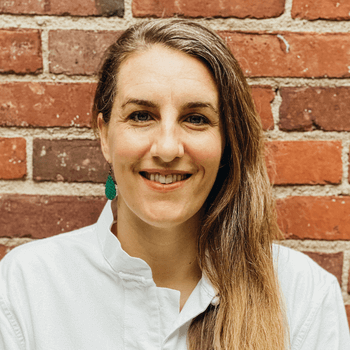Listen to This Article:
Wedding cake designers have the enviable job of helping couples celebrate one of life’s biggest milestones. But with that honor comes a serious responsibility—there are no do-overs on someone’s wedding day.
These professionals must consistently deliver cakes that are both stunning and delicious, often under tight deadlines and high expectations. A wedding cake isn’t just a dessert. It’s a statement piece, a photo op, and a reflection of the couple’s unique style.
From honing baking fundamentals to developing signature decorating techniques, building a career as a wedding cake designer requires creativity, precision, and a lot of patience. Whether you dream of creating towering tiered cakes or minimalist modern designs, here’s some of what it can take.
What Does a Wedding Cake Designer Do?
The simplest explanation is that wedding cake designers bake and decorate cakes for weddings. However, there is much more to the job than that. From client meetings to event logistics, a wedding cake designer can be part of the wedding day process from start to finish.
Here are a few important roles:
Working with Engaged Couples
Weddings are incredibly personal. You’re not just baking and decorating cakes that you love. Instead, it’s about getting to know the couple and what they want on their big day, then blending your signature style with their unique tastes to create a one-of-a-kind masterpiece.
Through consultations and tastings, you engage with the couple to help bring their vision to life. You’ll help pull out their ideas on what they like and what they don’t, which can be a challenge when working with two people who may have drastically different ideas. Creating the “perfect” cake for each couple can mean finding ways to combine their two preferences into one beautiful and tasty dessert.
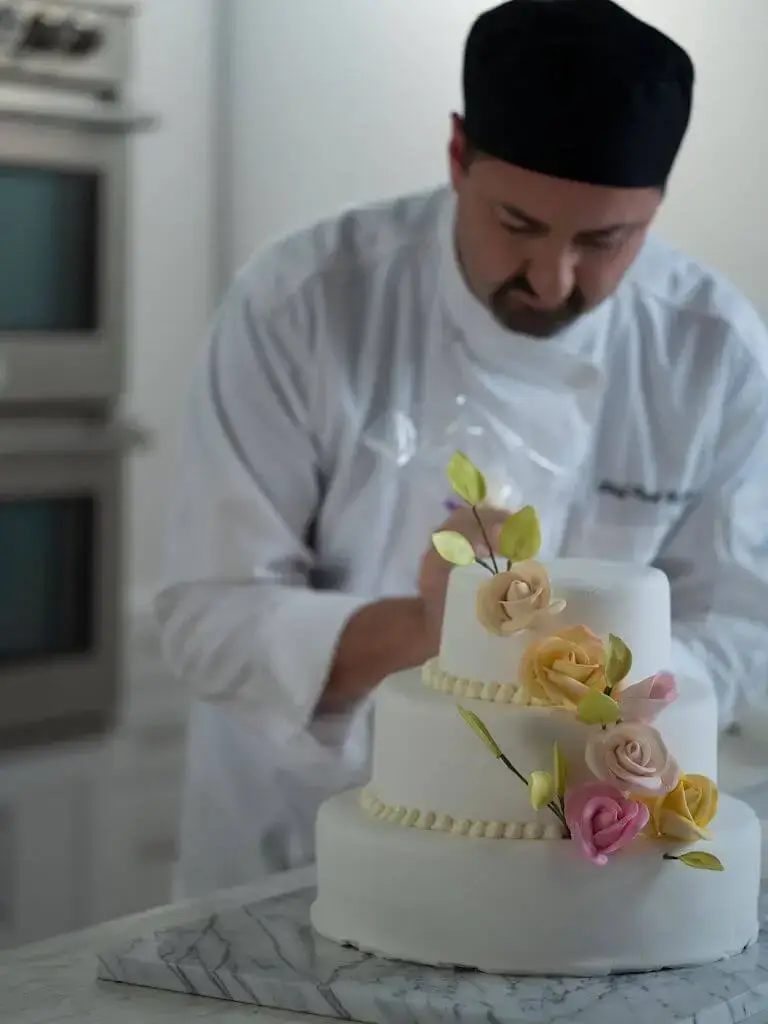
The wedding cake must check the boxes of being delicious and a visual element of the wedding that will be remembered for years to come.
Balancing Aesthetics and Taste
There is a visual component to all cooking, but nowhere is this so prominent as in the wedding cake industry. Cake designers have to bake delectable cakes while also creating a showpiece for their client couples. This requires imagination, an understanding of baking techniques, and decorative skills like frosting, piping, and making sugar flowers.
But while you do want the cake to look stunning in wedding photos, it’s also important to strike a balance between sculpture and flavor. You want people to be impressed with the visual presentation and the taste.
Helping Create a Stress-Free Wedding Day
Often, as the wedding cake designer, it’s your job to ensure the cake is where it needs to be, when it needs to be there, and in place in plenty of time for the happy couple to cut into it. This means you’ll need to think through how you’ll deliver the cake and work with the event planners or caterers to make sure the couple has everything they need.
It’s also vital to troubleshoot issues that could arise, like how you’ll transport the cake safely and deal with issues such as heat, high humidity, or venue constraints.
In addition to the challenges of each wedding, you may also need to juggle multiple orders simultaneously, especially during peak wedding season. This can require excellent time management skills, stress management, and attention to detail.
If, after reading this, you’re still excited about the thought of making wedding cakes, this guide can help you get started.
Essential Skills Every Wedding Cake Designer Needs
A wedding cake designer wears many hats: baker, artist, planner, and business owner. Here are the key skill sets you may need to build:
Culinary and Technical Skills
The role of wedding cake designer requires some of the same skills that any great cake baker needs. You’ll need more than creativity—you must also learn the fundamentals that ensure your cakes taste as good as they look and hold up under the demands of a big event.
Key skills can include:
- Cake Mixing Methods: Understand creaming, sponge, and chiffon techniques to achieve the right texture and structure for different cake styles.
- Tiered Cake Construction: Stack and support multi-tiered cakes securely for safe transport from kitchen to venue.
- Flavor Development & Pairing: Create delicious, well-balanced flavor combinations that wow guests and reflect the couple’s tastes.
- Structural Knowledge: Use internal supports and dowels to ensure your designs are beautiful and structurally sound.
- Food Safety & Quality Control: Maintain high standards for hygiene, storage, and transport, from small desserts to producing cakes at scale for weddings and large events.
*Information may not reflect every student’s experience. Results and outcomes may be based on several factors, such as geographical region or previous experience.
Wedding Cake Decorating Techniques
Not only does the cake need to taste delicious, but it also needs to be visually appealing and match the tone of the wedding. The decorative touches are what help set a cake apart. Your creativity can shine through here.
Start by learning how to smooth and finish buttercream and fondant for a clean, flawless base. From there, focus on developing consistency in popular decorating methods, including:
- Piping techniques: practice consistent pressure and control for borders, lacework, rosettes, filigree
- Fondant & gumpaste work: cover cakes cleanly and create bows and sculpt figures
- Sugar flowers: craft roses, peonies, orchids, ranunculus, etc.
- Hand-painting and airbrushing: apply watercolor effects or gradients
- Texture and stenciling: add dimension with ruffles, ridges, and embossed fondant patterns
- Metallic accents: use edible gold leaf, silver luster dust, and other shimmering details
Finally, stay inspired and competitive by keeping up with trends in the wedding cake industry—whether that’s minimalist designs, bold colors, or unique structural elements. Becoming proficient in these techniques can help you turn each cake into a memorable work of art.
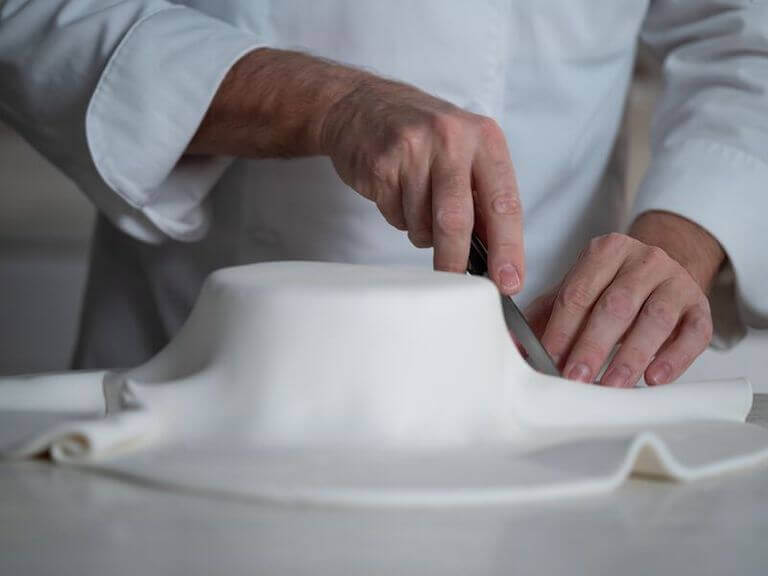
Decorating skills like working with fondant are important skills to develop as a wedding cake designer.
Client Communication Skills
The wedding day is all about the couple, so it’s essential that you listen to their desires for the cake. What kind of theme do they have? What colors are they using? How many people will be attending? Where is the reception located? All of these details matter when designing a wedding cake.
However, it’s not only important to listen, it’s also important to clearly communicate any boundaries or limitations. You want to guide the couple toward having realistic expectations. Ensure they understand how the process works and what you need from them.
If there are any last-minute changes or ambitious design requests, handle them with professionalism and empathy. If a couple’s vision includes elements or techniques you haven’t done before, it’s okay to be honest, but don’t be afraid to stretch your skills if you feel confident in your time and resources. Many cake designers grow by taking on new challenges, so long as they’re approached with care, communication, and a bit of prep.
From the Field
Chef Instructor Tammie Barnhill was once asked to recreate birch bark from a client’s family home, and rose to the challenge by researching and experimenting until she nailed the look. Creative requests like these can lead to some of your most memorable work.
Business & Operational Skills
If you want to have a business as a wedding cake designer, it’s important that you develop bakery business skills in addition to culinary skills.
One of the most important business skills is knowing how to price your cakes accurately, factoring in things like ingredients, materials, time, delivery, and overhead to ensure you’re not undercharging for your work. Beyond pricing, you’ll be responsible for managing your inventory, orders, timelines, and contracts.
Marketing is another key business skill for growing a wedding cake business. While word of mouth is one of the best forms of marketing, it’s important that you also learn to market your services. Social media marketing can be one of the least expensive ways to market your business, and platforms like Instagram and TikTok might be good avenues to explore.
By combining creative talent with solid business skills, you could set yourself up for long-term success in the wedding cake industry.
Education and Training Options
So, how can an aspiring cake baker and designer gain these skills? You don’t need a formal degree to become a wedding cake designer, but education and practice are important. There are multiple options for building your education and skills.
- Attend a Baking & Pastry Program: A structured program, like the Baking & Pastry Arts program at Auguste Escoffier School of Culinary Arts, can help you discover the science behind baking and the art of cake decorating. These types of programs can give you hands-on experience and repetition to help build precision and muscle memory.
- Take a Specialty Cake Decorating Class: Look for workshops or online classes that focus on teaching specific techniques such as sugar flowers, airbrushing, or tiered cake construction.
- Learn by Doing: Consistent practice is key for building and refining your skills. Make cakes for friends, enter competitions, or practice replicating trending designs you see online.
Students at Escoffier can explore a number of baking and pastry disciplines. The Cake Design & Decorating course, for example, is all about cakes, from mixing methods and cake styles to basic icings, frosting, fondant, and assembly, to delicate piping and decoration.
*Information may not reflect every student’s experience. Results and outcomes may be based on several factors, such as geographical region or previous experience.
In cake decorating classes, students work on repetition. They won’t pipe one frosting flower—they’ll pipe hundreds. They’re training their bodies to do the work automatically, building muscle memory with a variety of piping tips. Just like practicing with a chef’s knife in a Culinary Arts program, Baking & Pastry students practice to gain command over their piping bags.
After they’ve completed their programs, all Baking & Pastry students must complete at least one pastry externship. Aspiring cake decorators can seek work in a wedding cake bakery where they’ll be able to see how a bakery is run and continue to practice their skills.
Even talented home bakers can benefit from additional training in areas like scaling recipes, cake structure, and presentation when getting started in the wedding cake industry.
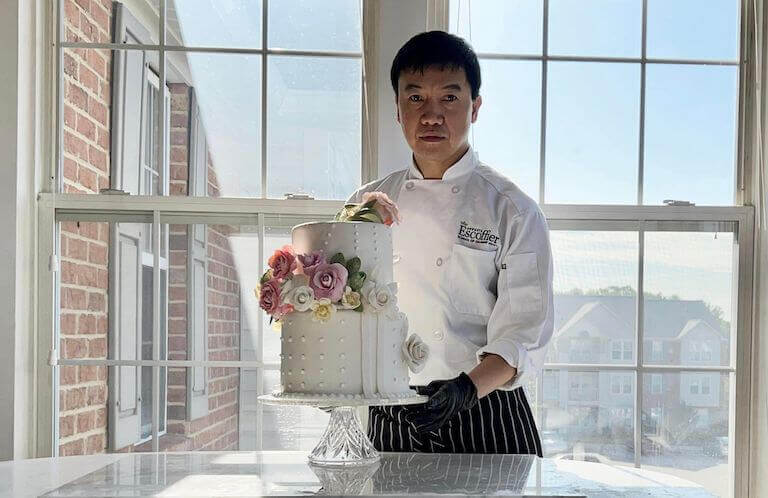
Danny Nguyen, online Baking & Pastry Associate Degree Graduate, shows one of his beautiful wedding cakes.
Developing Your Signature Style
As you gain experience, you might start to notice patterns in the types of cakes you enjoy designing most. Maybe you gravitate toward lush, gumpaste florals, or minimalist lines, or whimsical color palettes. Developing a signature style can help you stand out in a competitive market, attract couples who share your vision, and even streamline your workflow.
But that doesn’t mean you need (or should) limit yourself. In fact, versatility can be just as important, especially for building a loyal client base. Many wedding cake designers develop a wide range of skills so they can create styles depending on the couple’s wishes. Some couples will bring in photos of cakes they love or request something that pushes your creativity into new directions, and that’s part of the fun.
Over time, you may decide to stick to a signature style if your client base is big enough.The big names in wedding cakes, like Ron Ben-Israel and the late Sylvia Weinstock, are known for signature styles. It helped them gain recognition, and allowed them to charge higher prices.
Examples of wedding cake style niches
- Whimsical and bold
- Minimalist and modern
- Romantic and floral
- Vintage or rustic
Building a Wedding Cake Portfolio That Gets Clients
A strong portfolio is one of the most powerful marketing tools you can have. It should showcase your styles, techniques, and attention to detail.
Your portfolio should consist of images of cakes you’ve created from different angles, including close-ups. Don’t be afraid to cut into that pretty cake and shoot a slice so viewers can see the lovely layers and start thinking about what it must taste like.
If you don’t have any paying clients yet, that’s okay. Your portfolio images don’t have to be cakes you made for clients. You can bake and decorate cakes simply to help build your portfolio and showcase your skills and creativity.
Focus on capturing high-quality images of your cakes. You can develop food photography skills independently or work with a professional photographer to help build a strong portfolio of Instagram-worthy images.
Tips for Taking High-Quality Images of Wedding Cakes
- Use Natural Light – Shoot near a window with diffused daylight.
- Declutter the Background – Use a clean, neutral background to keep the focus on the cake.
- Shoot at Cake Level – Get down to the same height as the cake for the most flattering angle.
- Take Multiple Angles – Capture straight-on, side, angled, and overhead shots to show all the details.
- Highlight Details – Zoom in on unique decorations, textures, and toppers.
- Use a Tripod – Keep the camera steady to capture sharp images, especially in low light.
- Edit Lightly – Adjust brightness and contrast to enhance, not alter, the cake’s true appearance.
- Stage Simply – A cake stand, soft florals, or elegant linens can elevate the look without distraction.
- Shoot Before Delivery – If possible, photograph the cake in your studio where you control lighting and setup.
- Use a Decent Camera (or Phone) – A DSLR is ideal, but newer smartphones can produce excellent results when used well.
How to Work With Clients: From Consultation to Cake Cutting
It’s important to understand the process you need in place from start to finish and how you’re going to create a memorable client experience along the way. This can help simplify your work moving forward and can reduce stress along the way.
Here are some key parts of the cake designing process:
Initial Consultation
During the initial consultation, you’ll discuss the couple’s wedding theme, style, and guest count. They may have inspiration photos to share with you of cake designs they like. If so, ask them questions like, “What do you love about this cake?” and “Are there elements we can borrow while making it unique to your day?”
This is also where you’ll want to learn about any dietary restrictions the couple has for their wedding cake.
In addition to asking the couple questions during this consultation, you also want to provide them the opportunity to ask questions of you. This meeting is where you and the couple can learn if you’re the right fit for their wedding cake desires. You’d rather find out early on whether what the couple wants is something that you want to design.
Tastings & Flavor Pairings
Tastings allow couples to sample different cake flavors, fillings, and frostings before making their final decision. While some couples know exactly what they want, many need your guidance to find the right flavor combinations.
As a wedding cake designer, you can suggest popular pairings, like lemon cake with raspberry filling or almond and amaretto, and offer creative options they may not have considered. By asking about dietary restrictions during the initial consultation, you can help ensure that you have options that the couple can try during the tasting.
It can also be helpful to explain how certain flavors and fillings will work with the cake’s design, size, and the wedding setting. Your goal is to make sure the cake not only looks beautiful but also tastes amazing on the big day.
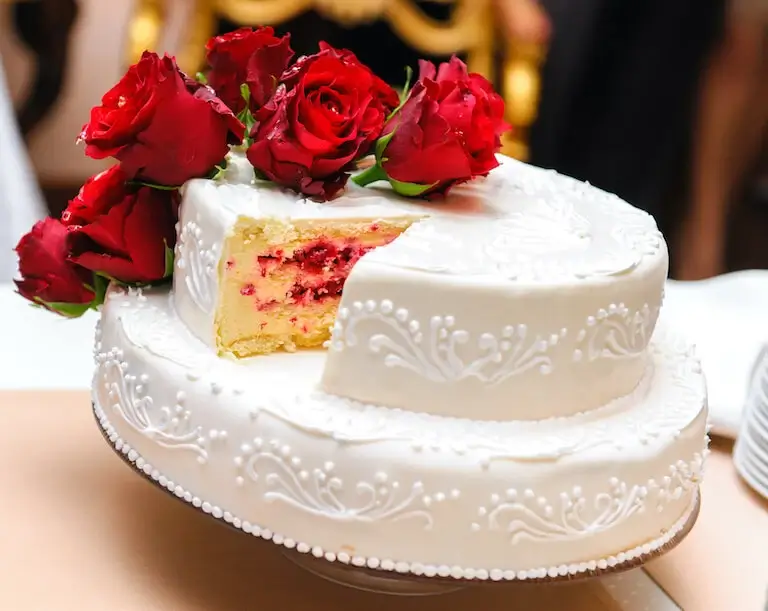
Couples may need help choosing good flavor pairings for their wedding cake.
Sketching the Design
Once you know what style of cake the couple is looking for, it’s time to get to work sketching ideas from your notes. You may choose to sketch a few cakes for the couple to choose from. When the sketches are complete, include a description with details such as the number of tiers, the colors, textures, and any florals for the couple to review.
When designing, it’s also helpful to be familiar with classic cake styles popular in your region. Tiered cakes, for example, remain a beloved choice for many couples particularly in the South, where stacked designs adorned with fondant or intricate florals are often requested. In the Northeast, you may find modern, minimalist designs, while in parts of the Southwest, sculpted elements like cacti or thistles frequently take center stage. Understanding regional preferences can help you offer designs that resonate with your clients and reflect local traditions.
And no matter your location, be open with the couple about what’s realistic based on the timeframe, budget, and environment of the venue.
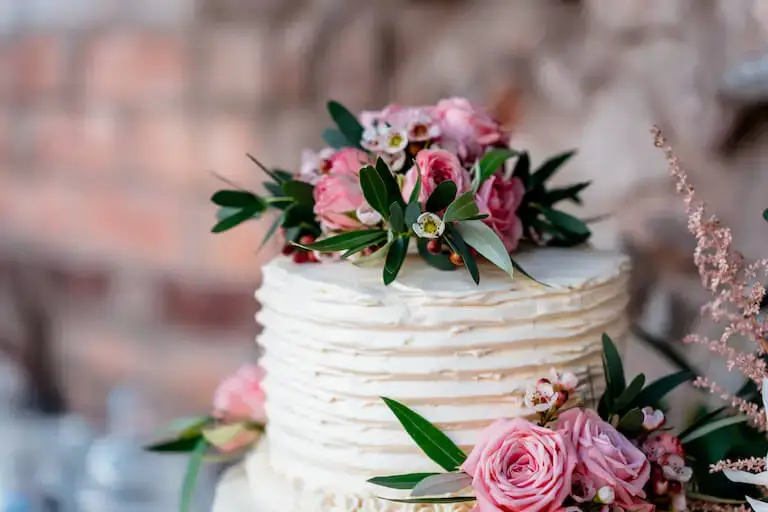
From floral and romantic to modern and minimalist, choosing a style of wedding cakes to specialize in can help set you apart from the competition.
Final Touches
With wedding cakes, it’s not always as simple as taking the order and preparing the cake. There are many details and steps involved in the process. It’s important to confirm all the details, such as the final headcount, prior to beginning the cake. You’ll also want to confirm the delivery time and contact information for who will be onsite at the venue.
It’s helpful to keep careful notes throughout the process. This can be especially important if your services are booked well in advance and you’re working with multiple couples at once.
Providing cake-cutting instructions to the couple or caterer can make their special moment smoother and stress-free.
Behind the Scenes: Logistics, Transport, and Day of Set-Up
Even the most stunning cake can be compromised by poor planning or unexpected weather. That’s why careful logistics are just as important as baking and decorating.
When possible, transport the cake to the venue in unstacked tiers and assemble them on-site to help reduce the risk of damaging them during delivery. Bring an emergency kit with essentials like piping bags, extra frosting, and an offset spatula for any last-minute touch-ups.
Ensure you arrive early and know the venue layout in advance. Have a plan for how you’ll get the cake to the cake display area and consider obstacles like stairs, narrow doorways, or a lack of air conditioning. It’s also smart to have a backup plan, especially for outdoor weddings, in the case of rain, wind, or heat that could affect the cake’s appearance and stability.
Finally, protect yourself from the start with a detailed contract. This should outline the cake design, flavors, delivery timeframe, setup details, refund policies, and disclaimers for factors beyond your control such as weather conditions for outdoor events.
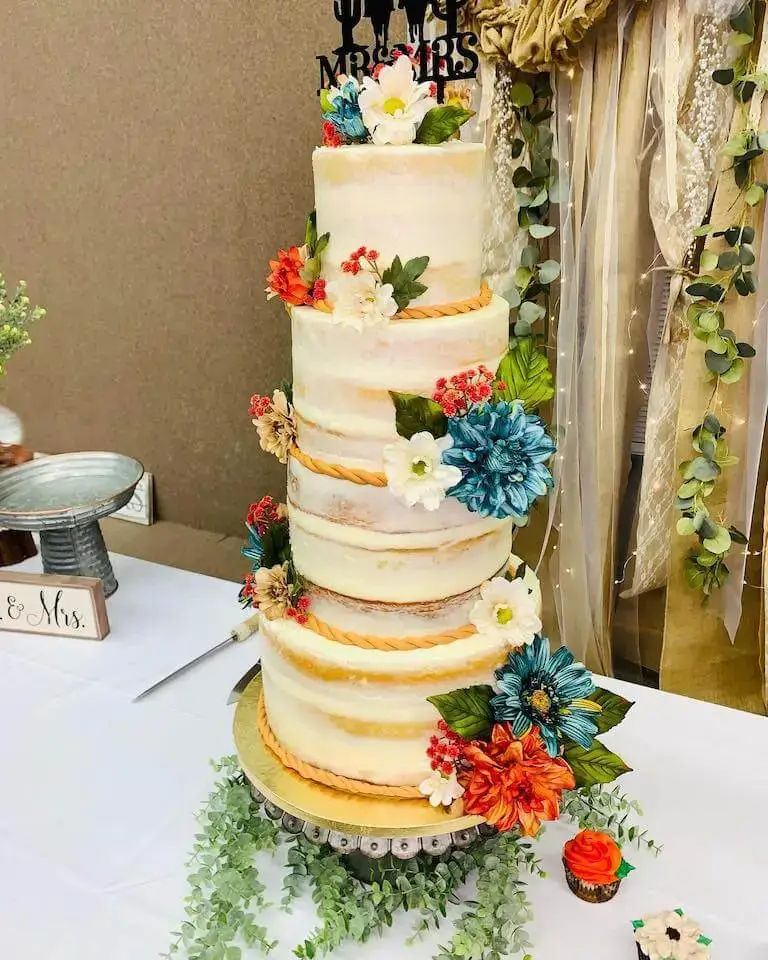
Tall and intricate wedding cakes like this one by Escoffier online Baking & Pastry Graduate Robin Martinez often need to be assembled on-site.
Frequently Asked Questions About Becoming A Wedding Cake Designer
How Long Does It Take to Become a Wedding Cake Designer?
The time it takes to become a wedding cake designer can vary based on your experience and goals. Some people start by decorating cakes as a hobby and gradually turn it into a career through practice, which can take years.
Enrolling in a formal program like a Baking & Pastry Arts program can provide you with a strong foundation in as little as 60 weeks. Many aspiring designers also gain experience under cake artists or by taking specialized decorating courses.
Do I Need a Degree to Do This?
No, but it can be helpful to complete a Baking & Pastry program to gain a competitive edge, whether you want to get a job as a pastry chef or start your own business. Training can also help prepare you for real-world challenges while helping you further refine your skills.
How Much Do Wedding Cake Designers Make?
As with many businesses, the income ranges widely based on your location, experience, business model, and the clientele you choose to serve. In general, the salary can vary from about $35,000/year for entry-level positions and young businesses to about $85,000/year or more for experienced and in-demand businesses.
Can I Make Wedding Cakes From Home?
Yes, there are many designers who start as home bakers and build up from there. Be aware of limitations and restrictions based on where you live and local cottage food laws.
Turn Your Passion into a Career
If you love baking and enjoy putting your creative eye to work on decorating cakes, wedding cake design could be a good fit for you. You can hone your skills through regular practice and real-world experience. Remember that building a strong portfolio can go a long way in attracting potential clients.
If you want to level up your knowledge and experience, Escoffier’s Baking & Pastry Arts program may be just what you’re looking for. You can develop skills from cake design and decorating to building your own business. Reach out today to find out how you can take the next step toward a sweet and successful career.
CHECK OUT THESE ARTICLES NEXT!
- How You Can Open a Bakery: 7 Steps to Success
- Pastry Chef vs. Baker: What’s the Difference?
- Sugar Sculpting Explained: The Intricate Craft Behind Edible Art
This article was originally published on September 21, 2021, and has since been updated.

